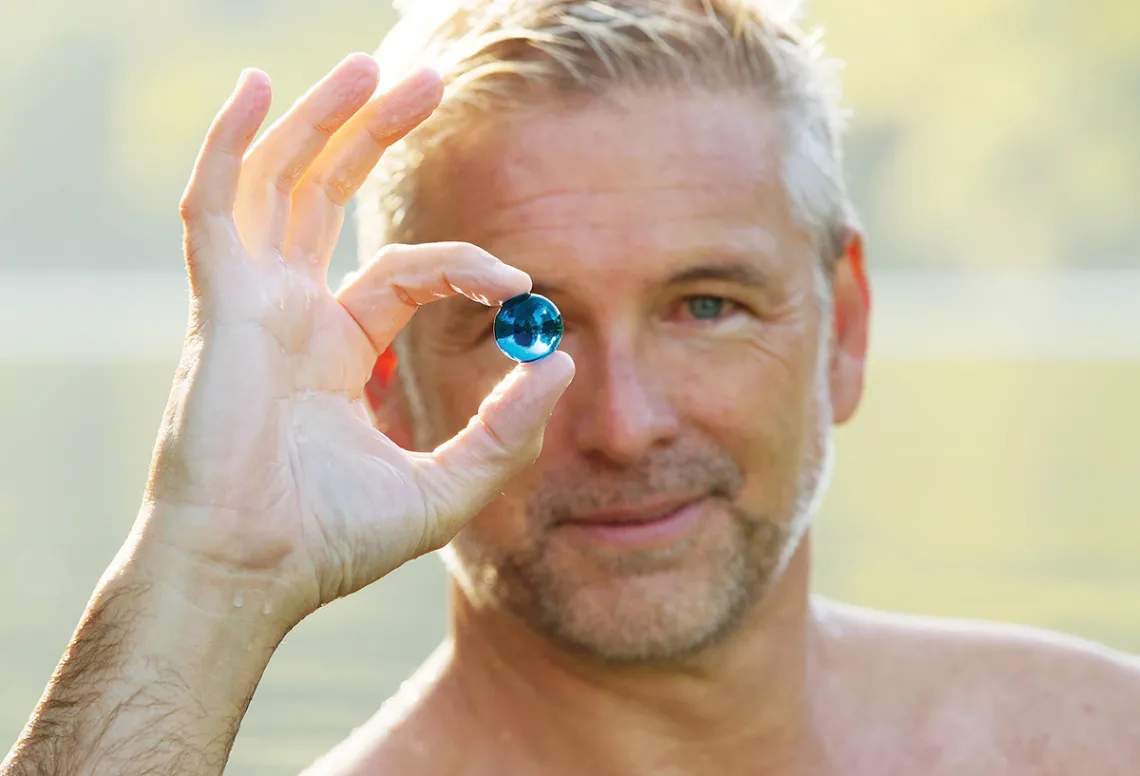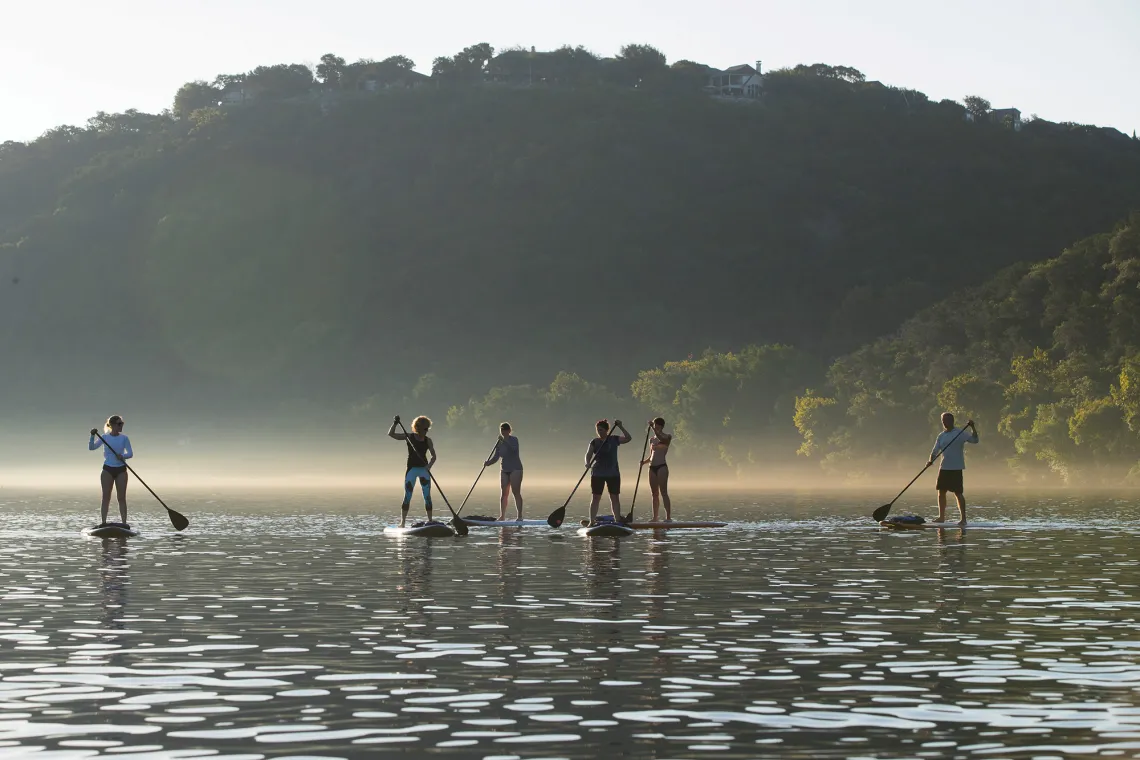Water is Life
Alumnus and preservationist Wallace J. Nichols makes it easy to care about our Earth

As surely as the sun sets every day over the Pacific Ocean, marine biologist Wallace J. Nichols ’03 gets asked the same question whenever he gives a public talk.
“Why in the world did you go to the Arizona desert to study sea turtles?”
Nichols — an unconventional author and wild water advocate who calls himself a “silo-busting, entrepreneurial scientist” — has a humorous reply at the ready.
“Well, I learned to scuba dive in quarries in Indiana,” he says. “So, of course, I went to study sea turtles in Arizona.”
It’s all true. An East Coast boy who always loved the water, Nichols first strapped on a scuba tank and mask in the deep limestone quarries of the Hoosier State, where he was studying biology and Spanish at DePauw University.
And he went to the University of Arizona to study sea turtles for two very good reasons.
“There’s pretty good access to the ocean and sea turtles from Tucson,” Nichols says by phone from his home in Monterey, on California’s central Pacific Coast. In a mere four hours, an enterprising grad student in the desert city can reach the northern point of the turtles’ feeding grounds in the Sea of Cortez in Mexico.
“If you want,” he adds, “you can drive every weekend to scuba dive.”
And the university “has a long history of graduating students in sea turtles,” says Nichols, who got his doctorate in wildlife ecology and evolutionary biology in 2003. He studied under a powerhouse trio of experts in the ecology of the Southwest U.S. and Baja California: Donald Thomson, a specialist in the reef fish of the Sea of Cortez; Cecil Schwalbe, a world expert on desert tortoises; and global tortoise authority John Erickson.
Nichols had loved turtles of all kinds from an early age.
“I grew up near the water,” he says. “I was always in the water,” in rivers, lakes and the open sea.
Born in New York, he was raised in the far northeast corner of New Jersey, near the mighty Hudson River, flowing south to the Atlantic. Nichols spent his childhood summer vacations with his family along the Atlantic Coast, from Cape Cod to the Jersey shore to the Chesapeake Bay.

Wallace J. Nichols, far right, during a paddleboard yoga class at Lake Austin Spa in Austin, Texas.
The incipient scientist conducted research while playing in the water with his brother and cousins.
“I caught snapping turtles and put numbers on their back,” he says. Though he can’t attest to the reliability of his boyhood findings, he was trying to answer questions like “How many turtles are there in the Chesapeake?”
“I liked math and I liked turtles. I even dreamed about them. And I made a career out of it.”
From the mid-1990s to the early 2000s, Nichols spent six months every year in the field, traveling up and down the Sea of Cortez and the Pacific coast of Baja California. Covering about 3,000 miles of coastland, he went to countless fishing villages.
“I did a lot of miles,” he says, cruising the back roads in a lumbering International Harvester Travelall, an early model SUV.
Nichols’ study of sea turtles was almost derailed before it started. Sea turtles were well on their way to extinction, victims of polluted waters, beachside development and a strong culinary market. His mentors advised him to study a more promising species.
Always the rebel, Nichols jumped in anyway. He told his professor, “If I waste time, I’ll take responsibility. I’m gonna give it a shot.” Looking back, he says, his insistence on sticking to turtles “was a combination of naivete and insight.”
In Mexico, he not only gathered data on the scarce turtles, he also talked to the fishermen who had helped lead them to the verge of extinction by overhunting. Diners in London enjoyed turtle soup in those days; homesick Mexicans living far from their native Baja longed for turtle meat. And the local fishermen “would have turtle feasts — gather the family together, celebrate,” Nichols says. “It was reverential.”
The Mexican government was protecting the turtle breeding grounds down on Michoacán’s Pacific coast, but not guarding the feeding grounds in the Sea of Cortez.
While Nichols worked with government environmental officials, he also took a different approach, working with the hunters directly. He’d go out with them in their boats and ask how many turtles they ate in a year.
“Maybe they’d say ‘10.’ Then we would ask, ‘What if you ate eight?’ and then explain that if they kept eating the turtles in large numbers, their livelihood would disappear.
“It’s hard work changing a culture,” Nichols notes. “It was important for the fishermen to have buy-in” — and for the gringo outsiders to respect their dignity.
Nichols’ community efforts to save the sea turtles weren’t part of his dissertation, but he had found the work he wanted to do.
His winding academic path — after his undergraduate work in biology and Spanish, he’d picked up an economics master’s at Duke before doing his Ph.D. — had given him a toolbox of different disciplines to do boundary-jumping science outside the university system.
“My interest was always in solving problems,” he says. “I wanted to roll up my sleeves — and my pants — to solve problems. A lot of academics describe and don’t solve. I always wanted to do both.”
Armed with his doctorate, Nichols became a research associate at the California Academy of Sciences, a museum and aquarium that is the oldest science institute west of the Mississippi. A prolific writer, he turns out scholarly and popular articles, and through his part-time post he gets his ecological message out to the general public.
“They’ll put my work in exhibitions. I do writing projects. I do print media, videos. It’s a nice relationship.”
In the past year, he also became a senior fellow with the Center for Blue Economy, a research institute in Monterey dedicated to the health of the planet’s oceans. In between, he’s helped found numerous ecology nonprofits, and for a time he was a regular staff scientist at the Ocean Conservancy. But he’s discovered he does his best work unmoored from a full-time job.
His current “big thing” is the Blue Mind project, summed up in the tongue-twisting title of his 2014 book, “Blue Mind: The Surprising Science That Shows How Being Near, In, On, or Under Water Can Make You Happier, Healthier, More Connected, and Better at What You Do.”
“It came out of the sea turtle stuff,” he explains. “Neuroscientists are studying this: the emotional, psychological, cognitive and spiritual benefits of water.”
As an ocean swimmer, diver and surfer, Nichols long ago learned the psychological benefits of splashing into ocean waves, dipping into quarry water and dancing in the first monsoon rains of a Tucson summer.
In the book, Nichols writes of everything he’s learned about the gifts of water, gifts that enrich sea turtles and humans, not to mention the planet at large. A laudatory Washington Post review, noting that the book was “rooted in real research,” declared it a “fascinating study of the emotional, behavioral, psychological and physical connections that keep humans so enchanted with water.”
Climate change is already here, Nichols points out, and his Blue Mind efforts help people understand its effects.
“Sea level is rising, and the redistribution of water is a reality. The planet is warming. It’s not a debate; it’s a reality. There will be more rain in some places and less rain elsewhere.”
If people can be helped to understand the importance of wild water and the joy it can bring, they are more likely to support efforts to mitigate climate change and to work for the preservation of lakes, rivers and oceans.
And that includes the Sea of Cortez, the home of Nichols’ beloved sea turtles. Nichols has lately been involved in Billion Baby Turtles, a fundraising effort to pay local people living near breeding grounds to protect the area.
Happily, today the turtles are doing a little better. With their population slowly increasing, the species has been “downlisted” from endangered to threatened.
“That’s good!” Nichols says. Clearly, though, there’s still work to be done.
